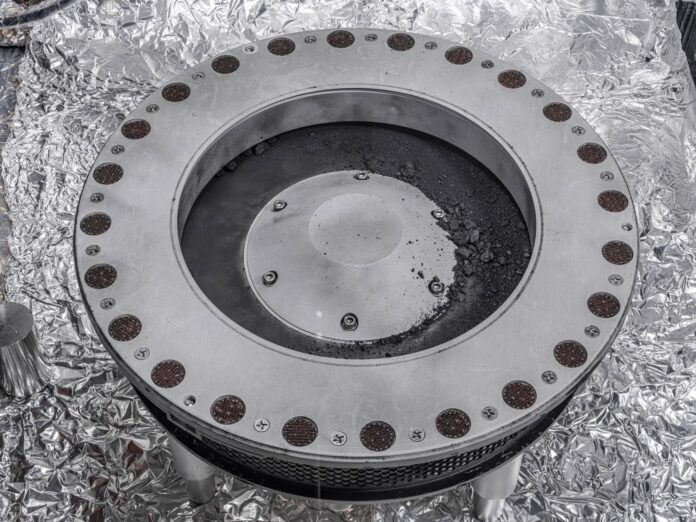OSIRIS-REx is the first U.S. mission to collect a sample from an asteroid. It returned to Earth on Sept. 24, 2023, to drop off material from the 4.5-billion-year-old asteroid Bennu.
Now, NASA has made headlines for showing off the asteroid material for the first time since it landed in September. The sample is the most extensive carbon-rich asteroid sample ever delivered to Earth. It will help scientists determine the origins of life on our planet for generations to come.
Initial studies of the sample show evidence of high carbon content and water, which together could indicate the building blocks of life on Earth may be found in the rock.
60 grams of asteroid material were the target for the OSIRIS-REx sample collection mission. NASA Johnson curators have painstakingly disassembled the sample return hardware for the past ten days to see the bulk sample inside. The collection head, canister lid, and base had extra asteroid material covering them when the initial scientific canister lid was opened. The abundance of additional material slowed down the meticulous gathering and confining of the primary sample.
Director NASA Johnson Vanessa Wyche said, “Our labs were ready for whatever Bennu had in store. We’ve had scientists and engineers working side-by-side for years to develop specialized gloveboxes and tools to keep the asteroid material pristine and to curate the samples so researchers now and decades from now can study this precious gift from the cosmos.”
The first sample was subjected to “quick-look” analyses during the first two weeks, which included gathering data from a scanning electron microscope, infrared measurements, X-ray diffraction, and chemical element analysis. A 3D computer model of one of the particles was also created using X-ray computed tomography, showcasing its complex innards. This first look revealed that the sample included large amounts of carbon and water.
Dante Lauretta, OSIRIS-REx principal investigator, University of Arizona, Tucson, said, “As we peer into the ancient secrets preserved within the dust and rocks of asteroid Bennu, we are unlocking a time capsule that offers us profound insights into the origins of our solar system. The bounty of carbon-rich material and abundant water-bearing clay minerals are just the tip of the cosmic iceberg. These discoveries, made possible through years of dedicated collaboration and cutting-edge science, propel us on a journey to understand our celestial neighborhood and the potential for life’s beginnings. With each revelation from Bennu, we draw closer to unraveling the mysteries of our cosmic heritage.”
The mission’s science team will continue characterizing the samples and performing the analyses required to achieve the mission’s scientific objectives during the ensuing two years. NASA will preserve at least 70% of the model at Johnson for use in future research by experts worldwide.
Researchers from numerous U.S. institutions, NASA partners JAXA (Japan Aerospace Exploration Agency), CSA (Canadian Space Agency), and other scientists worldwide will examine the regolith’s properties as part of OSIRIS-REx’s science program. Later this fall, more samples will be lent to the University of Arizona, Space Center Houston, and Smithsonian Institution for public display.
